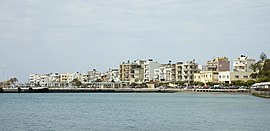Ierapetra
|
Ierapetra Ιεράπετρα |
|
|---|---|

View of town port.
|
|
| Coordinates: 35°0′N 25°44′E / 35.000°N 25.733°ECoordinates: 35°0′N 25°44′E / 35.000°N 25.733°E | |
| Country | Greece |
| Administrative region | Crete |
| Regional unit | Lasithi |
| Government | |
| • Mayor | Theodosios Kalantzakis (since 01 September 2014) |
| Area | |
| • Municipality | 554.0 km2 (213.9 sq mi) |
| • Municipal unit | 394.8 km2 (152.4 sq mi) |
| Highest elevation | 18 m (59 ft) |
| Lowest elevation | 0 m (0 ft) |
| Population (2011) | |
| • Municipality | 27,602 |
| • Municipality density | 50/km2 (130/sq mi) |
| • Municipal unit | 23,708 |
| • Municipal unit density | 60/km2 (160/sq mi) |
| Community | |
| • Population | 16,139 (2011) |
| Time zone | EET (UTC+2) |
| • Summer (DST) | EEST (UTC+3) |
| Postal code | 72x xx |
| Area code(s) | 284x0 |
| Vehicle registration | AN |
| Website | www.ierapetra.gr |
| Employment |
| Primary sector: 49% |
| Secondary sector: 14% |
| Tertiary sector: 37% |
Ierapetra (Greek: Ιεράπετρα, meaning "sacred stone"; ancient name: Ἱεράπυτνα Hierapytna) is a town and municipality in the southeast of the Greek island of Crete.
The town of Ierapetra (in the local dialect: Γεράπετρο Gerapetro) is located on the southeast coast of Crete, along the beach of Ierapetra Bay. It lies south of Agios Nikolaos and southwest of Sitia and is an important regional centre. With its 16,139 inhabitants (in 2011) it is the most populous town in the regional unit of Lasithi, and the fourth town of Crete. Ierapetra is nicknamed "bride of the Libyan Sea" because of its position as the only town on the south coast of Crete.
Ierapetra has had a place in the history of Crete since the Minoan period. The Greek and later Roman town of Hierapytna was on the same site as present day Ierapetra. In the Classical Age Hierapytna became the strongest town of eastern Crete and as a Dorian city in continual rivalry with Praisos, the last Minoan city in the island. Later, in the 3rd century BC, Hierapytna was notorious for its tendency to piracy and took part in the Cretan War along with other Cretan cities in the side of Philip V of Macedon against Knossos and Rhodes. Its importance as independent state ended when it was conquered by the Romans in 67 BC (the last free city in Crete) and was surpassed by the city of Gortyn. The Roman conquest of Ierapetra occurred about the same time as that of Knossos, Cydonia and Lato. Today remains of the Roman harbor can still be seen in the shallow bay. In AD 824 it was destroyed by Arab invaders, only to be rebuilt as a base for pirates again.
...
Wikipedia


